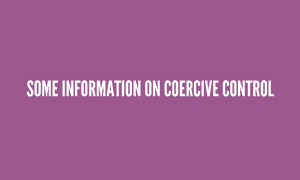For years it has been recognised and understood that not all abuse is physical, but previously it had been difficult to speak out against abuse that left emotional trauma, and not physical scars or bruising. On the 29th December 2015, a piece of legislation was introduced to aid in tackling domestic and emotional abuse further.
[su_quote]The legislation does not apply to a single incident. It requires a purposeful
pattern of behaviour, that takes place over time in order for one individual to
exert power, control or coercion over another.[/su_quote]
The term ‘Coercive’ allows people to understand that domestic abuse is more than just physical acts of violence, but about how a perpetrator builds a pattern of behaviour over time in order to deny the victims and survivors freedom and to take away any ability to make their own decisions. Coercive control within any form of relationship is deemed a high-risk factor and a factor that Police, along with our Criminal Justice System, are keen to eliminate. It’s important for us to help raise awareness on this issue.
Most coercive control is committed alongside physical acts of violence, and the threats of such violence further facilitate this control. Examples of coercive control:
- Preventing or controlling access to transport and/or employment
- Depriving them of their basic needs
- Monitoring their time
- Monitoring their phone/laptop
- Taking control over aspects of their life, such as where they go, who they see etc.
- Criminal damage
- Repeatedly putting them down and making them feel worthless
- Control of finances
- Assault
- Threats to hurt or kill them or people close to them
- Depriving them of specialist support such as access to medical care
- Isolating them from friends or family
Coercive control is mainly hidden and hard to identify, however, if you are experiencing any of the above and/or physical abuse; there are specialist organisations that can provide the relevant support and assistance you need.
Some evidence which can help in relation to identifying a perpetrator can include:
- copies of emails, text messages they send you etc.
- evidence of abuse via social media
- photographs of injuries/assaults
- recordings, transcripts, CCTV
- bank records to show financial control
- diary entries kept describing instances of coercive control
Emotional abuse is a crime.
If you have concerns about your relationship then please call the National Domestic Violence Helpline on 0808 2000 247 – this is a freephone helpline that operations 24 hours a day, 7 days a week.
You can also call the Men’s Advice Helpline on 0808 801 0327 or The National LGBT Helpline on 0300 999 5428.
Footnote: You could also find support organisations using our ONLINE DIRECTORY

Comments are closed.